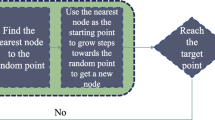Abstract
Recently, the path planning has become one of the key research hot issues in the field of autonomous vehicles, which has attracted the attention of more and more related researchers. When RRT (Rapidly-exploring Random Tree) algorithm is used for path planning in complex environment with a large number of random obstacles, the obtained path is twist and the algorithm cannot converge quickly, which cannot meet the requirements of autonomous vehicles’ path planning. This paper presents an improved path planning algorithm based on RRT algorithm. Firstly, random points are generated using the circular sampling strategy, which ensures the randomness of the original RRT algorithm and improves the sampling efficiency. Secondly, an extended random point rule based on cost function is designed to filter random points. Then consider the vehicle corner range when choosing the adjacent points, select the appropriate adjacent points. Finally, the B-spline curve is used to simplify and smooth the path. The experimental results show that the quality of the path planned by the improved RRT algorithm in this paper is significantly improved compared with the RRT algorithm and the B-RRT (Bidirectional RRT) algorithm. This can be seen from the four aspects of the time required to plan the path, mean curvature, mean square deviation of curvature and path length. Compared with the RRT algorithm, they are reduced by 55.3 %, 68.78 %, 55.41 % and 19.5 %; compared with the B-RRT algorithm, they are reduced by 29.5 %, 64.02 %, 39.51 % and 11.25 %. The algorithm will make the planned paths more suitable for autonomous vehicles to follow.








Similar content being viewed by others
References
Khatib, O.: Real-time obstacle avoidance for mobile robots manipulators and mobile robots. J. Int. J. Robot. Res. 5(1), 90–98 (1986)
Hart, P.E., Nilsson, N.J., Raphael, B.: A formal basis for the heuristic determination of minimum cost paths. IEEE Trans. Syst. Sci. Cybern. 4(2), 100–107 (1968)
Lu Y., Yi S., Liu Y., et al.: A novel path planning method for biomimetic robot based on deep learning. Assem. Autom. 36(2), 186–191 (2016)
Jiang, M., Wang, F., Sun, L.: Research on path planning of mobile robot based on improved ant colony algorithm. Chin. J. Sci. Instrum. 4(2), 113–121 (2019)
Lavalle, S.M., Kuffner, J.R.J.J.: Randomized kinodynamic planning. Int. J. Robot. Res. 20(5), 378–400 (2001)
Kuffner, J.R.J.J., Lavalle, S.M.: RRT-connect: An efficient approach to single-query path planning. Proceedings of the IEEE International Conference on Robotics and Automation (ICRA), vol. 2, pp. 995-1001. IEEE, San Francisco (2000)
Bruce, J., Veloso, M.M.: Real-time randomized path planning for robot navigation. In: Kaminka, G.A., Lima, P.U., Rojas, R. (eds.) RoboCup 2002. Robot Soccer World Cup VI, RoboCup (2002)
Karaman, S., Frazzoli, E.: Sampling-based algorithms for optimal motion planning. Int. J. Robot. Res. 30(7), 846–894 (2011)
Jordan M, Perez A.: Optimal Bidirectional Rapidly-Exploring Random Trees,”[EB/OL]. [2021-10-07]. http://dspace.mit.edu/bitstream/handle/1721.1/79884/MIT-CSAIL-TR-2013-021.pdf?sequence=2.
Adiyatov, O., Varol, H.A.: Rapidly-exploring random tree based memory efficient motion planning. IEEE International Conference on Mechatronics and Automation, Takamatsu, pp. 354-359 (2013)
Gammell, J.D., Srinvasa, S.S., Barfoot, T.D.: Informed RRT*: Optimal sampling-based path planning focused via direct sampling of an admissible ellipsoidal heuristic. International Conference on Intelligent Robots and Systems. pp. 2997-3004. IEEE, Chicago (2014)
Qureshi, A.H., Ayaz, Y.: Intelligent bidirectional rapidly-exploring random trees for optimal motion planning in complex cluttered environments. Robot. Auton. Syst. 68, 1–11 (2015)
Qureshi, A.H., Mumtaz, S., Ayaz, Y., et al.: Triangular geometrized sampling heuristics for fast optimal motion planning. Int. J. Adv. Rob. Syst. 12(2), 86–93 (2015)
Pereira, N., Ribeiro, A.F., Lopes, G., et al.: Path planning towards non-compulsory multiple targets using TWIN-RRT*. Ind Robot 43(4), 370–379 (2016)
Bascetta, L., Iñigo Arrieta, M., Prandini, M.: Flat-RRT*: A sampling-based optimal trajectory planner for differentially flat vehicles with constrained dynamics. IFAC-Papers Online, vol. 50, no. 1, pp. 6965-6970 (2017)
Tahir, Z., Qureshi, A.H., Ayaz, Y., et al.: Potentially guided bidirectionalized RRT* for fast optimal path planning in cluttered environments. Robotics 108, 13-27 (2018)
Liu, H., Zhang, X., Wen, J., et al.: Goal-biased Bidirectional RRT based on Curve-smoothing. IFAC-Papers Online 52(24), 255–260 (2019)
Li, Y., Xu, D., Zhou, C.: Cooperation path planning of dual-robot based on self-adaptive stepsize RRT. Robot 42(5), 606–616 (2020)
Yang, Z., Wang, Y., Qi, A.: Improved RRT* algorithm based global obstacle avoidance planning for unmanned surface vehicles. ShipSci. Technol. 41(23), 167–172 (2019)
Li, Y., Wei, Wu, Gao, Y., et al.: PQ-RRT*: An improved path planning algorithm for mobile robots. Expert systems with applications, vol. 152 (2020)
Veneri, M., Massaro, M.: The effect of Ackermann steering on the performance of race cars. Veh. Syst. Dyn. 59(6), 907–927 (2021)
Acknowledgements
This research was funded by National Social Science Fund National Emergency Management System Construction Research special project: Research on the path of improving the quality and upgrading of urban comprehensive emergency management capability under major emergencies, grant number 20VYJ023 and This research was funded by Key project of science and Technology Research Plan of Chongqing Education Commission: Theory and Practice of self-organization optimization of traffic block chain in interlaced area under the environment of intelligent network connection, grant number KJZD-K202000704.
Author information
Authors and Affiliations
Corresponding authors
Additional information
Publisher’s Note
Springer Nature remains neutral with regard to jurisdictional claims in published maps and institutional affiliations.
Rights and permissions
About this article
Cite this article
Huang, G., Ma, Q. Research on Path Planning Algorithm of Autonomous Vehicles Based on Improved RRT Algorithm. Int. J. ITS Res. 20, 170–180 (2022). https://doi.org/10.1007/s13177-021-00281-2
Received:
Revised:
Accepted:
Published:
Issue Date:
DOI: https://doi.org/10.1007/s13177-021-00281-2




